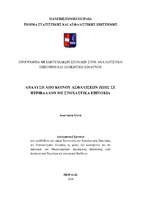Ανάλυση από κοινού ασφαλίσεων ζωής σε περιβάλλον με στοχαστικά επιτόκια

Προβολή/
Λέξεις κλειδιά
Ασφάλεια ζωής ; Στοχαστικά επιτόκιαΠερίληψη
Η διπλωματική εργασία πραγματεύεται τη μελέτη ομαδικών ασφαλιστήριων συμβολαίων
ζωής που αφορούν σε δύο άτομα, σε ένα οικονομικό περιβάλλον με στοχαστικά επιτόκια.
Συμβόλαια που καλύπτουν περισσότερες από μία ζωές ενδεικτικά βρίσκουν εφαρμογή στα
μέλη μιας οικογένειας, στους εργαζόμενους μιας επιχείρησης, ή στα μέλη ενός σωματίου. Η
ανάγκη για στοχαστικά επιτόκια προκύπτει από το γεγονός ότι η υπόθεση της ανεξαρτησίας
του επιτοκίου από περίοδο σε περίοδο δεν είναι ρεαλιστική.
Στο Κεφάλαιο 1 γίνεται παρουσίαση της βιβλιογραφίας που αφορά στα μοντέλα που έχουν
προταθεί για την κατάσταση επιβίωσης των ασφαλισμένων ατόμων καθώς και στα μοντέλα
που έχουν μελετήσει τη χρονική αξία του χρήματος. Και οι δύο αυτοί παράγοντες είναι
σημαντικοί για την αποτίμηση μιας ομαδικής ασφάλισης ζωής καθώς τα ασφάλιστρα και οι
ασφαλιστικές παροχές καταβάλλονται στο μέλλον και το ύψος τους καθορίζεται ανάλογα με
τον αριθμό των ατόμων που επιβιώνει εκείνη τη στιγμή.
Το Κεφάλαιο 2 παρουσιάζει τις υποθέσεις και την ανάλυση σχετικά με τη διακριτού χρόνου
στοχαστική διαδικασία AR(1) έντασης επιτοκίου, καθώς και τα μοντέλα εξόδου σύμφωνα από
τη Θεωρία Συμβάντων. Υπό το νόμο θνησιμότητας του Gompertz αναλύονται, σχετικά με τους
χρόνους ζωής δύο ατόμων, το ανεξάρτητο μοντέλο θνησιμότητας καθώς και δύο μοντέλα
εξαρτημένης θνησιμότητας, συγκεκριμένα της σύζευξης (copula) και του κοινού σοκ (common
shock).
Το Κεφάλαιο 3 εξετάζει τον τύπο του ασφαλιστηρίου συμβολαίου δύο ατόμων υπό το
καθεστώς της από κοινού επιβίωσης (joint first-to-die). Θεωρώντας ότι η ένταση ανατοκισμού
ακολουθεί μία AR(1) διαδικασία, μελετάται η τυχαία μεταβλητή προοπτικής απώλειας δίνοντας
εκφράσεις για τις δύο πρώτες ροπές της, για ένα συμβόλαιο καθώς και για ένα γενικό
χαρτοφυλάκιο συμβολαίων. Η ανάλυση αυτή επιτυγχάνεται μέσω της εφαρμογής δύο μεθόδων,
συγκεκριμένα της ατομικής συνάρτησης απώλειας και των ετήσιων στοχαστικών χρηματοροών.
Επίσης δίνεται η διάσπαση της συνολικής επικινδυνότητας του χαρτοφυλακίου τόσο στον
ασφαλιστικό κίνδυνο όσο και στον κίνδυνο λόγων επενδύσεων.
Στο Κεφάλαιο 4 γίνεται αντίστοιχη ανάλυση για ένα ασφαλιστήριο συμβόλαιο δύο ατόμων
υπό το καθεστώς τελευταίου επιζώντος (joint last-survivor) καθώς και για ένα χαρτοφυλάκιο
τέτοιων συμβολαίων.
Στο Κεφάλαιο 5, παρουσιάζεται μια αριθμητική εφαρμογή του μοντέλου που αναπτύχθηκε
στο Κεφάλαιο 3 για ασφαλιστήριο συμβόλαιο από κοινού ζωής, τόσο για ένα συμβόλαιο όσο
και για ένα ομοιογενές χαρτοφυλάκιο, υπό την επίδραση στοχαστικού επιτοκίου μέσω μιας
AR(1) διαδικασίας. Το πρόγραμμα που χρησιμοποιήθηκε για την ανάλυση ήταν το
Mathematica.
Τέλος, το Κεφάλαιο 6 συνοψίζει την εργασία.


